Prav (Правь), Yav (Явь) and Nav (Навь) are the three dimensions or qualities of the cosmos as described in the first chapter of the Book of Light and in the Book of Veles of Slavic Native Faith (Rodnovery). Older sources mention only Nav and Yav concepts of ancient slavic cosmology, similar to Yin and Yang in Taoism, and Prav was not part of the concept. The literal meanings of the Prav, Yav, and Nav words, are, respectively, "Right", "actuality" and "probability". They are also symbolised as a unity by the god Triglav. Already Ebbo documented that the Triglav was seen as embodying the connection and mediation between Heaven, Earth and the underworld / humanity; these three dimensions were also respectively associated to the colours white, green and black as documented by Karel Jaromír Erben.

Mokosh is a Slavic goddess. No narratives survive to the present day about this deity and so scholars must rely on academic disciplines like philology to discern details about her.

In the pre-Christian religion of Eastern and Southern Slavs, Rod is the god of the family, ancestors and fate. Among Southern Slavs, he is also known as Sud. He is usually mentioned together with Rozhanitsy deities. One's first haircut (postriziny) was dedicated to him, in a celebration in which he and the rozhanitsy were given a meal and the cut hair. His cult lost its importance through time, and in the ninth or tenth century he was replaced by Perun, Svarog and/or Svetevid, which explains his absence in the pantheon of Vladimir the Great.

Dziady is a term in Slavic folklore for the spirits of the ancestors and a collection of pre-Christian rites, rituals and customs that were dedicated to them. The essence of these rituals was the "communion of the living with the dead", namely, the establishment of relationships with the souls of the ancestors, periodically returning to their headquarters from the times of their lives. The aim of the ritual activities was to win the favor of the deceased, who were considered to be caretakers in the sphere of fertility. The name "dziady" was used in particular dialects mainly in Poland, Belarus, Polesia, Russia, and Ukraine, but under different other names there were very similar ritual practices, common among Slavs and Balts, and also in many European and even non-European cultures.

The Feast of the Holy Cross, or Feast of the Cross, commemorates the cross used in the crucifixion of Jesus. In the Christian liturgical calendar, there are several different celebrations which honor and celebrate the cross used in the crucifixion. Unlike Good Friday, which is dedicated to the passion of Christ and the crucifixion, these feast days celebrate the Cross itself, as the sign of salvation. It is chiefly celebrated by Roman Catholics, Eastern Orthodox, Oriental Orthodox, Old Catholics, Lutherans and Anglicans, and to a lesser extent by Presbyterians, Methodists and Baptists. The most common day of commemoration is September 14th for Churches that use the Gregorian calendar and September 27th for Churches that use the Julian calendar, Ge'ez calendar, or Coptic calendar.

The Matins Gospel is the solemn chanting of a lection from one of the Four Gospels during Matins in the Orthodox Church and those Eastern Catholic churches which follow the Byzantine Rite.

Paraskeva of the Balkans was an ascetic female saint of the 11th century. She was born in Epivates, near present-day Istanbul, and had visions of the Virgin Mary. After living in Chalcedon and Heraclea Pontica, she settled in a convent in the desert near the Jordan River. An angel told her to return to her homeland, and two years later she died at the age of 27. The cult of Saint Paraskeva began to spread in the 14th century from Bulgaria into the Danubian Principalities of Wallachia and Moldavia. There was confusion over her identity and attributes because her Greek name Παρασκευή "Paraskeuḗ, Paraskevi" means "Friday," and translations in other languages, such as Romanian and Serbian, were "Saint Friday". Her cult continues to be celebrated in many Orthodox countries, and her feast day is commemorated on October 14 in the Eastern Orthodox Church.

Saint Paraskevi of Iconium is venerated as a Christian virgin martyr. According to Christian tradition, she was born to a rich family of Iconium. Her parents were Christian, and Paraskevi was named as such because she was baptized on a Friday and because Friday was the day of Christ's Passion.
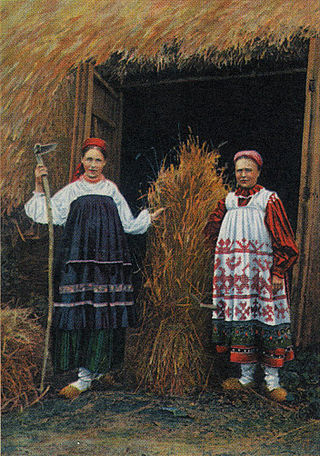
Dożynki is a Slavic harvest festival. In pre-Christian times the feast usually fell on the autumn equinox, in modern times it is usually celebrated on one of the Sundays following the end of the harvest season, which fall on different days in different regions of Europe.
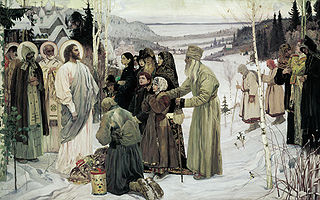
Holy Rus' or Holy Russia - is an important religious and philosophical concept which appeared from the 9th century and developed gradually from the 16th century to the 21st century by people in Grand Duchy of Moscow, East Europe, Central Eurasia and Great Russia. As a concept it has several meanings. It designates the Russian land as chosen by God and enlightened by the Christian faith. However, among the other spaces, Holy Rus' is not distinguished by geography, nor by the state it constitutes, nor by ethnicity, but by Eastern Orthodox Christianity.

Folk Orthodoxy refers to the folk religion and syncretic elements present in the Eastern Orthodox communities. It is a subgroup of folk Christianity, similar to Folk Catholicism. Peasants incorporated many pre-Christian (pagan) beliefs and observances, including coordinating feast days with agricultural life.

Festival of Perun, Perun's Day, Perunica is a Slavic festival in honor of the god Perun celebrated by modern Slavic neopagans (rodnovers); its existence in times before the Slavs began to be Christianized remains hypothetical.
Modern paganism, also known as contemporary paganism and neopaganism, is a collective term for new religious movements which are influenced by or derived from the various historical pagan beliefs of pre-modern peoples. Although they share similarities, contemporary pagan religious movements are diverse, and as a result, they do not share a single set of beliefs, practices, or texts.
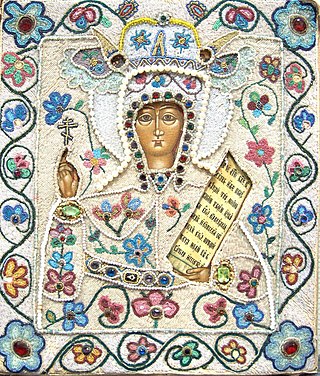
In the folk Christianity of Slavic Eastern Orthodox Christians, Paraskeva Friday is a mythologized image based on a personification of Friday as the day of the week and the cult of saints Paraskeva of Iconium, called Friday and Paraskeva of the Balkans. In folk tradition, the image of Paraskeva Friday correlates with the image of Saint Anastasia of the Lady of Sorrows, and the Saint Nedelya as a personified image of Sunday. Typologically, Paraskeva Pyatnitsa has parallels with day-personifications of other cultures, for example, the Tajik Bibi-Seshanbi.
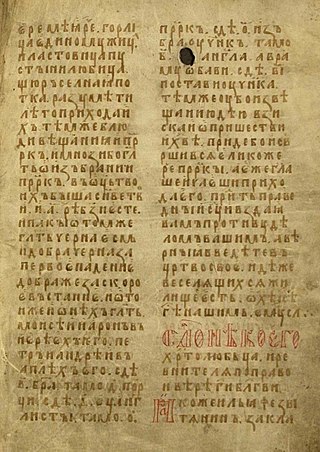
The Word of a certain Christ-lover and zealot for the right faith is a significant work of ecclesiastical Old East Slavic literature. It is an Orthodox work directed against folk customs and pagan beliefs and rituals.
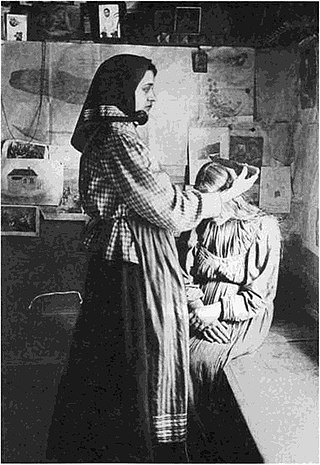
Apocryphal prayer is a prayer modeled on the church prayer, but containing a large number of insertions from folk beliefs, incantations, in some cases rearrangements or excerpts from apocrypha. Performed as apotropeia, it is also used for medicinal purposes. Apocryphal prayers are mostly texts of bookish origin. It is found in all collections of zagovory.

In the Church Slavonic written tradition, the Index of Repudiated Books is a list of writings forbidden to be read by the Orthodox faithful. The works included in this list are renounced. They include apocrypha opposed to Biblical canon. The Slavonic lists originate in translations of the Byzantine lists. In Rus' they have been known since the eleventh century. The Izbornik of Sviatoslav II of Kiev of 1073 contains an index of renounced books and is the earliest bibliographic monument from Rus'. The Index of Repudiated Books may be considered the Orthodox counterpart to the Catholic Index of Prohibited Books.

Adam Maldzis was a Belarusian historian, literary critic, author and journalist. He was described as "a patriarch of Belarusian humanities", "an excellent connoisseur of literature" and "a living bridge between Belarus and the scholars of Belarusian studies around the world". He was “the author of unique studies of the Old Belarusian literature”.

The Circle of Veles is an association of neo-pagan communities dedicated to the revival and promotion of Slavic native spirituality. The association venerates Veles, the Slavic god of wisdom, and regards Rod as the supreme deity, aligning itself with the Rodnovery tradition.

















